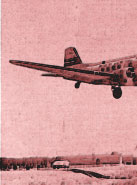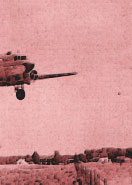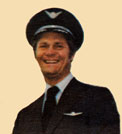 |
 |

When I think about landing the DC-3, I'm pretty happy with seeing a guy at about 80 knots over the fence, cutting his power just before the round out. This is the way we did it at North Central... best I recall about 18 landings a day. Maybe I got down to around 70 knots once on the approach to the ultra-short (at the time) 11L (at Minneapolis/St Paul Int'l). But Pete Wahl, in the left seat, said something and corrected me! 75 knots would probably be much more reasonable.
I think that we'd all agree that one thing that none of us likes to see is the DC-3 "three pointed". If they want to try that, I'd just as soon not be anywhere around; I'd rather be somewhere else - like a thousand miles away! We had guys on the airline that thought - repeat - thought that they were good enough to accomplish this consistently. The problem with that was, we had more than thirty DC-3's, and every one of them flew just a little bit differently from any other! From the vantage point of one who was riding along with some of these "aviators", it worked fine - in about nine out of ten cases. However, during that tenth case, it bit them in the rear end...hard! I've sat through some amazing leaps and swerves during some of these "arrivals". As I said, the majority of the time the guy was able to successfully make it work. But, once in awhile, the pilot (never mind who) might have been in a bit of a "crab" or misalignment with the hard-surfaced runway when he touched down three-point. From watching this, it appears to me that directional control is severely reduced in this touchdown attitude. In other words, if you were pointed off to one side or other of the runway at touchdown, then that was exactly where you were going to go, regardless of all your good intentions! In the expressive words of an old crop-duster friend of mine down in Texas - "Hold'er Newt, she's a-headed for the buckwheat!" Actually, at that particular moment in history, he was watching the arrival of an ill-fated Staggerwing Beach. And his unheard advice from the ramp didn't do a bit of good to aid the hapless pilot when the inevitable runway departure occurred! In my experience, this is exactly the situation you'll place yourself in if you attempt to three-point the venerable old "Douglas Racer". You'll use all the rudder and aileron that both God and Donald Douglas made available, along with whatever amount of power that Pratt & Whitney or Wright can muster on short notice, while you attempt to control the swerve! And remember that those Pratts are a little bit slower to accelerate than the Wrights. I'd still bet that we'll hear a squalling of the brakes and tires to keep it on the runway!
Now, something good! Unlike the B-17 (which, by the way, CAN be comfortably, consistently and easily three-pointed), this airplane lends itself well to the pilot "pinning" it when the inevitable slight bounce occurs! You don't need to exaggerate the "pinning" motion by raising the tail to a ridiculous stance. Just move the control yoke smoothly forward slightly (it doesn't take a lot) to regain your footing and continue a normal landing.
The easiest and most consistent landings that I've experienced in the DC-3 were those with a power off, "tail-low" touchdown. A knowledgeable bystander, watching from the tarmac, can always detect an amateur or inexperienced DC-3 pilot in two ways. First - the carrying of even a small amount of power through the touchdown and obvious "chopping" of the throttles immediately after the "chirp" of the tires. Second - the exaggerated tail high posture of the airplane being forced onto the runway for landing. These two things will always betray the pilot's inner hidden anxieties and lack of mastery of the machine. Now, to be perfectly honest, this technique works OK - well, that is, as long as the owner doesn't mind absorbing the increased brake and tire wear! And as long as you, the pilot, don't have any problem contending with the knowledgeable observer's smirk.
Also, we need to mention what might be considered an advanced technique, but one that we commonly used when operating into a short runway or attempting to make a certain taxiway. This required a feel for the airplane and a degree of currency (eighteen landings made a day's work for us in the airplane's local service airline heyday) that none of us are likely to completely re-achieve today. While you're still in a touchdown attitude after landing, smoothly apply braking action with the tail in the air during the rollout. This technique enabled pilots to maintain their braking until very near the turnoff point. Smooth coordination of the rudder and brakes, along with the elevator, is absolutely essential to performing this maneuver. At the completion, smoothly lower the tailwheel to the runway while you still have elevator authority, then unlock the tailwheel and accomplish the turnoff.
R.L. Sohn - copyright 1998
